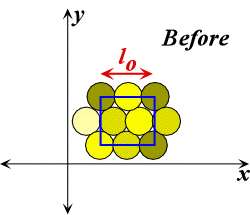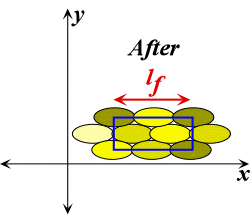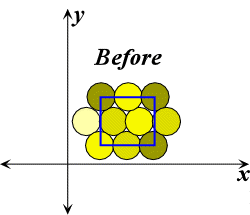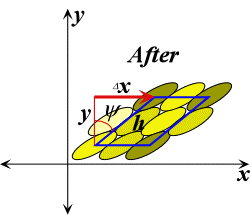Measurements of Strain
In order to measure the amount of strain that has taken place in a rock body one must know the configuration of the body prior to the strain event. Material lines are imaginary lines that can be thought of as connecting material points (van der Pluijm and Marshak, 1997). For example, material lines may connect the centers of an array of grains in a sandstone or plutonic rock.
For any given material line structural geologists can measure changes in its length and changes in its position. The measure of the change in the lengths of material lines is termed elongation (e), stretch (s), and quadratic elongation (l). Rotations that accompany simple shear are measured as angular strain (y), while magnitudes are expressed as shear strain (g). Equations for these different measures of strain are provided in Tables 2 and 3. Key parameters are illustrated in Figures 38 and 39.


Figure 38. An array of grains with material lines (blue) subjected to pure shear.
|
Elongation (e) |
|
| (86) | |
|
Quadratic elongation (l) |
|
 |
(87) |
|
Stretch (s) |
|
| (88) | |
|
*See Figure 38 for illustrative definition of lf and lo. |
|
Table 2. Equations for e, l, and s.


Figure 39. An array of grains with material lines (blue) subjected to simple shear.
|
Angular shear (y) |
|
| (89) | |
| (90) | |
| (91) | |
 |
(92) |
|
Shear Strain (g) |
|
| (93) | |
|
*See Figure 39 for illustrative definitions
of |
|
Table 3. Equations for y and g.